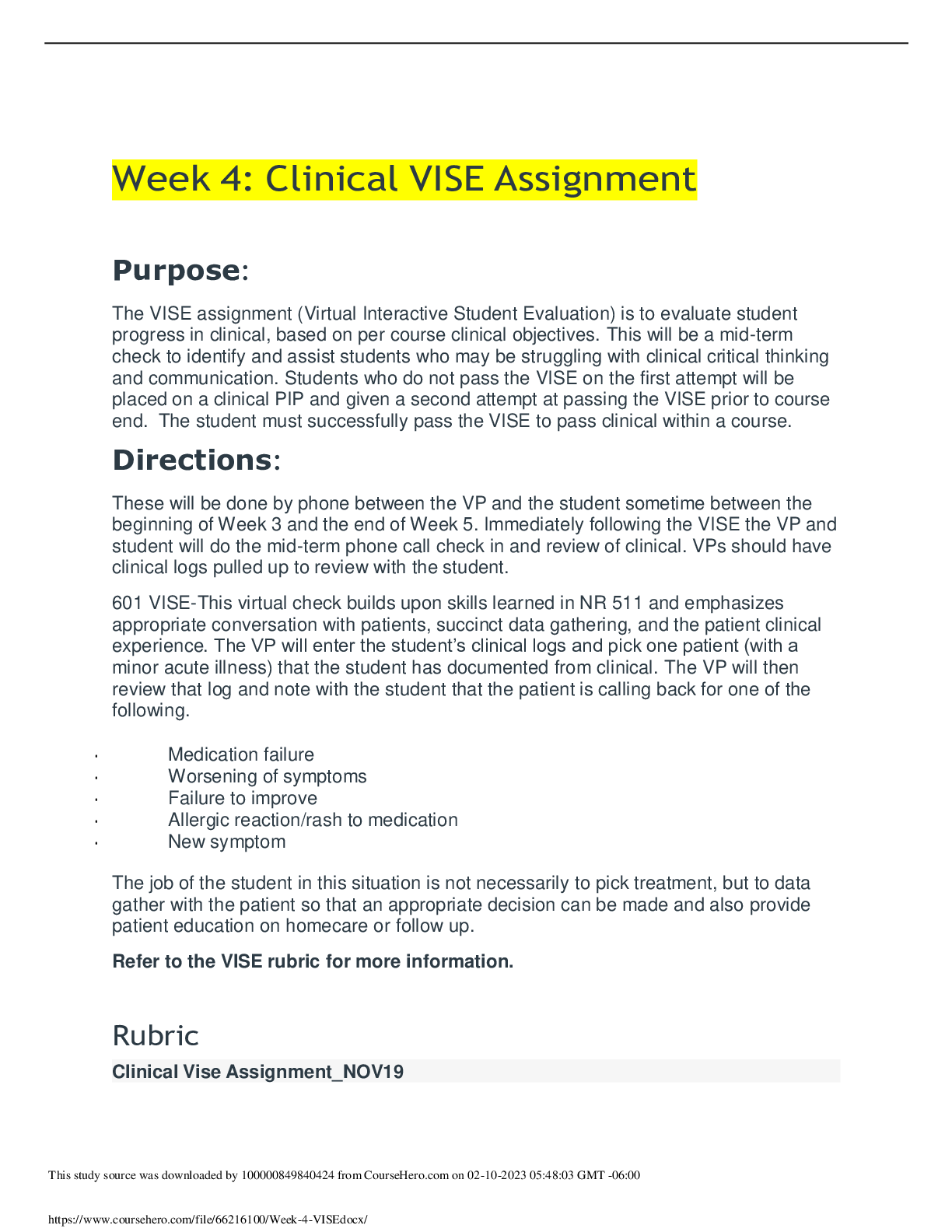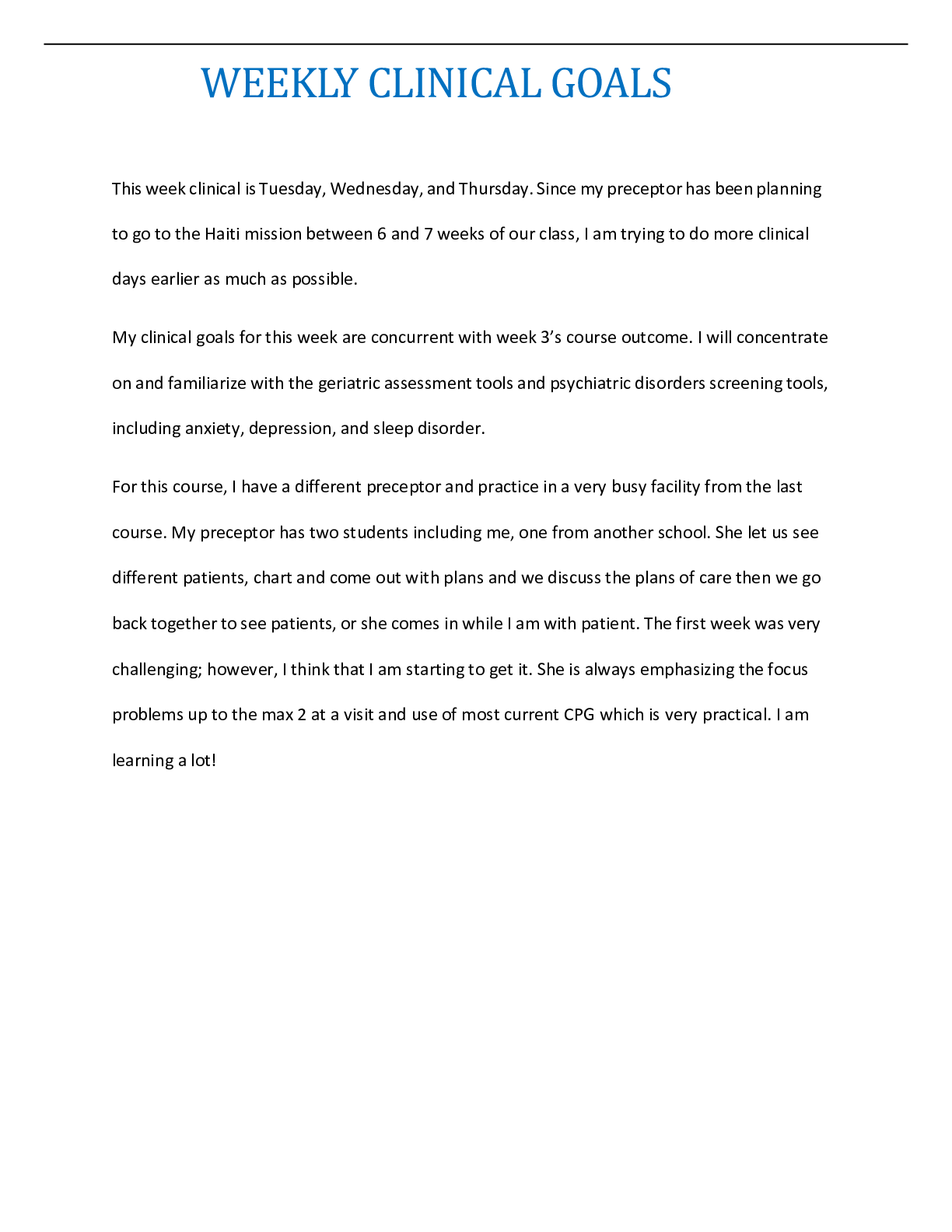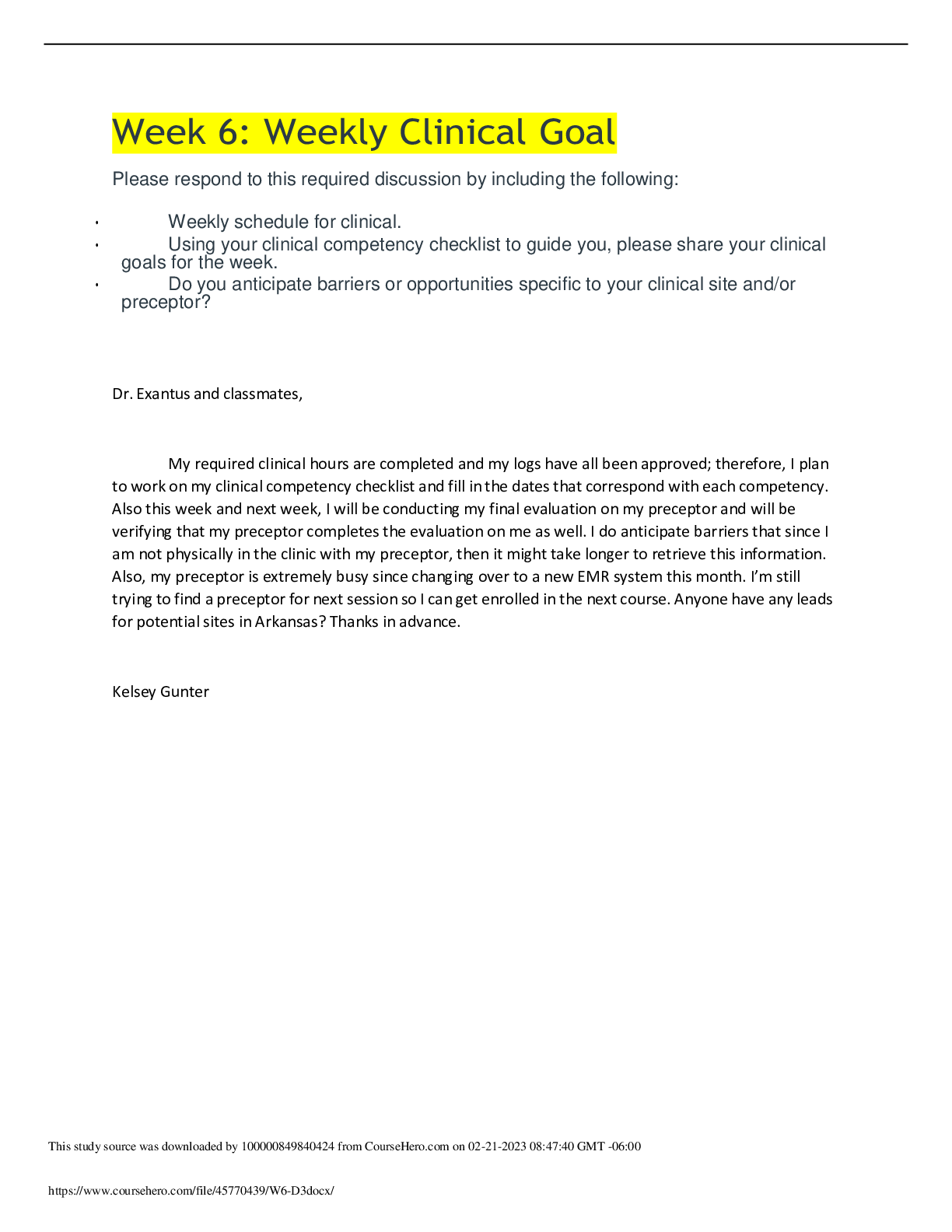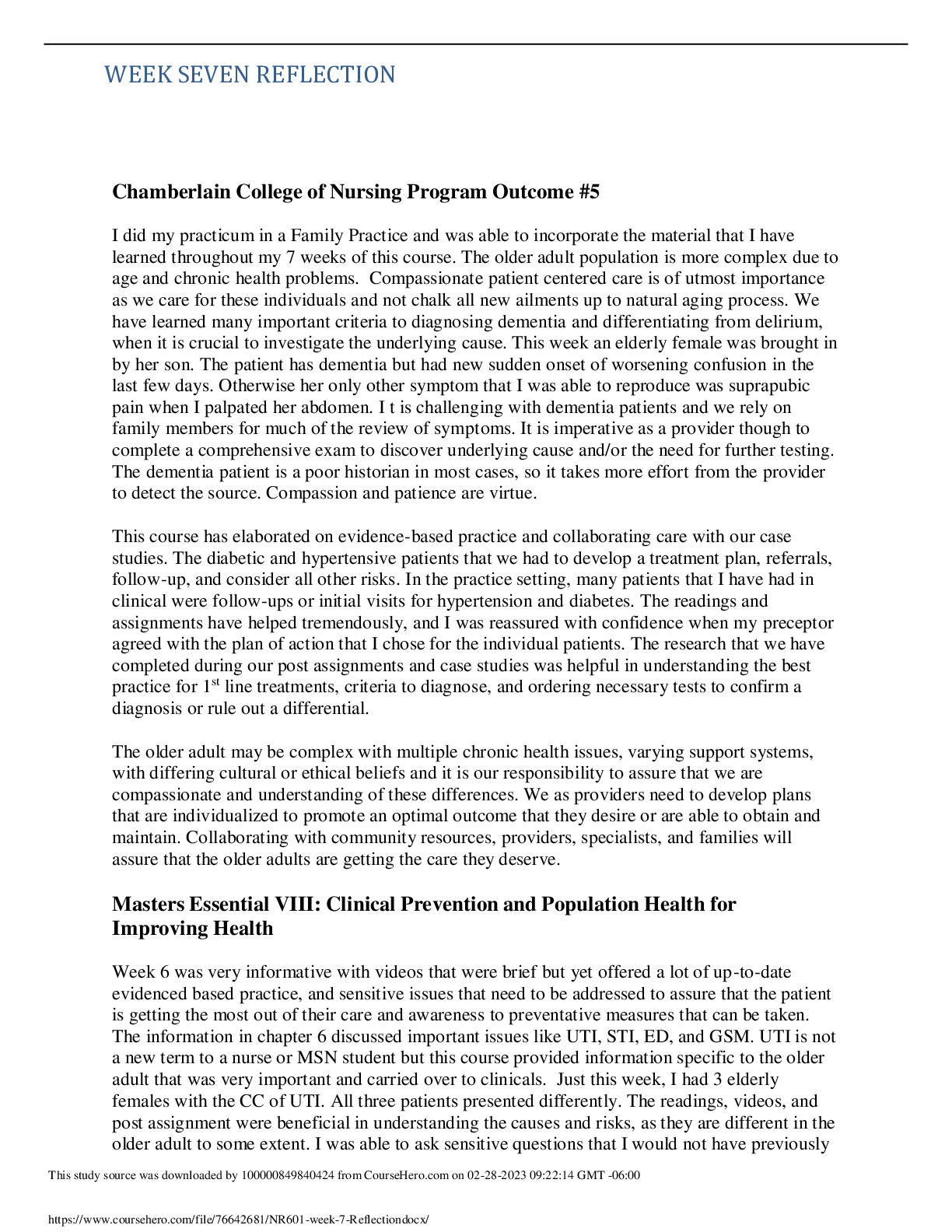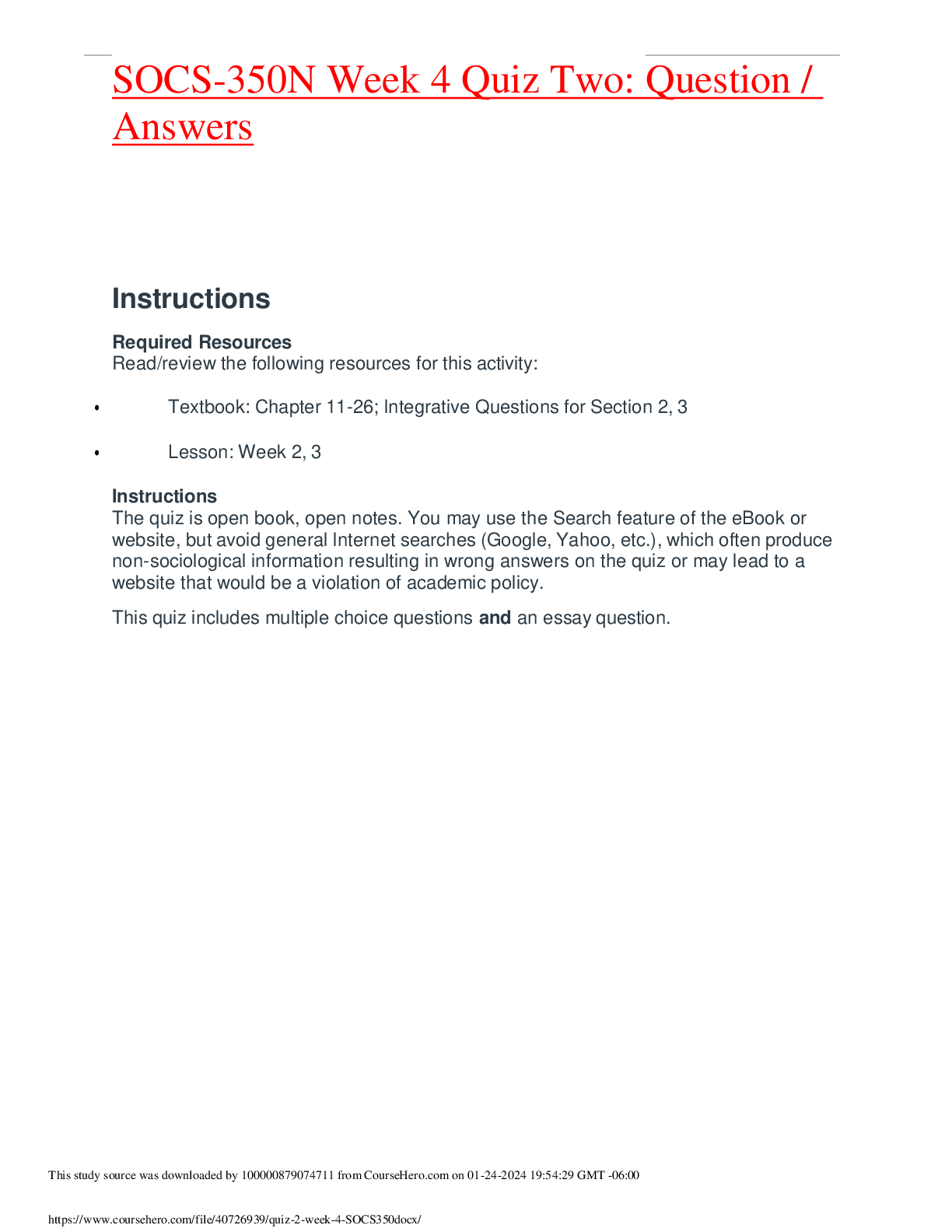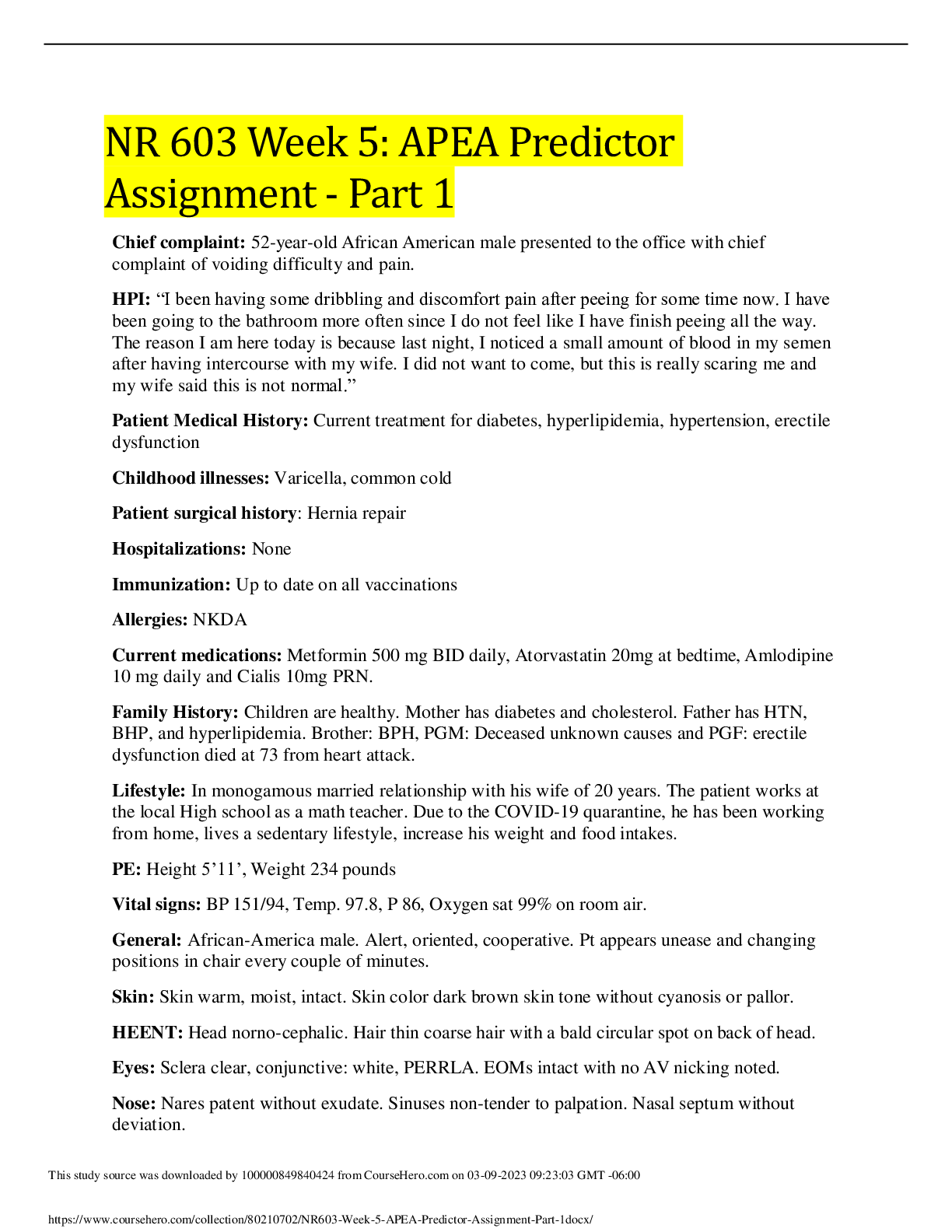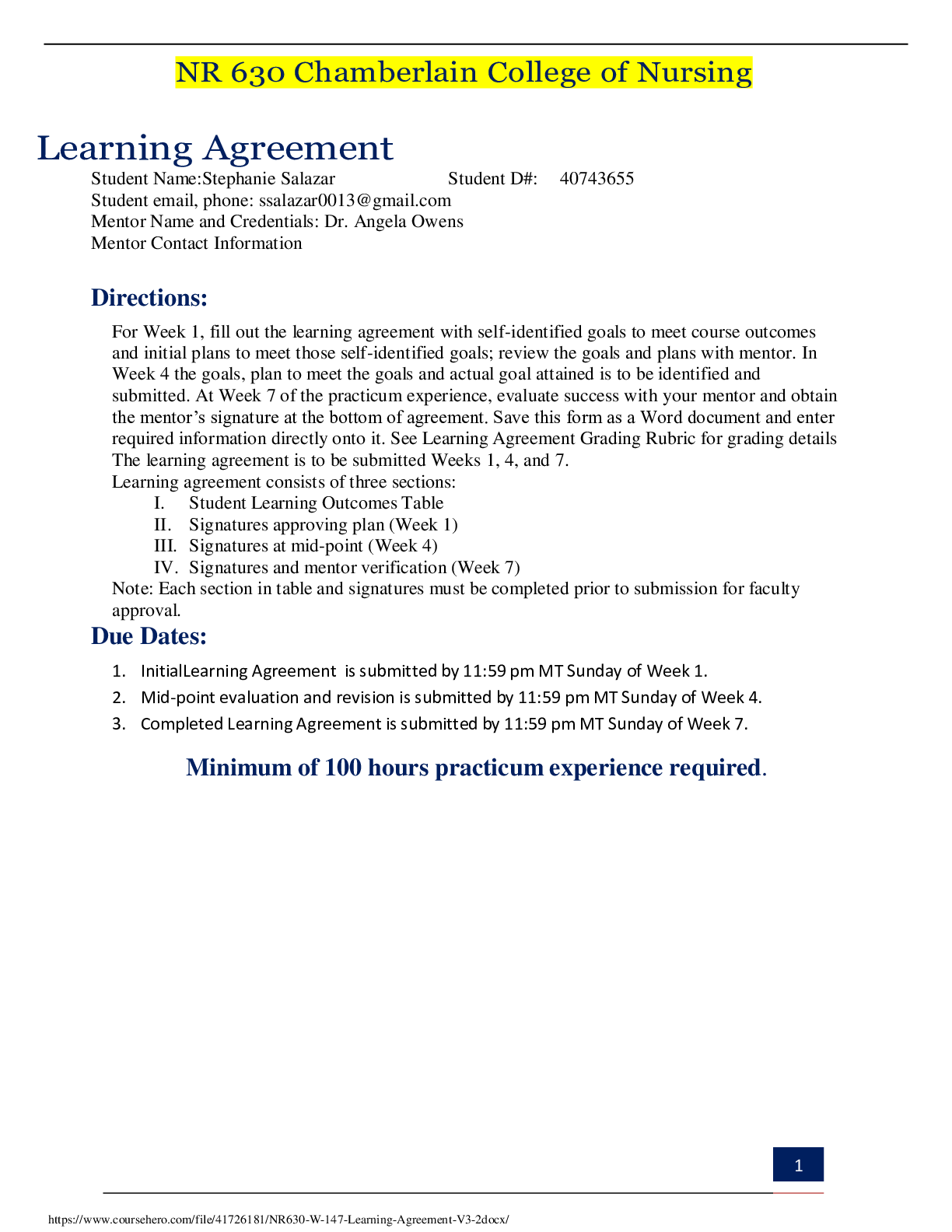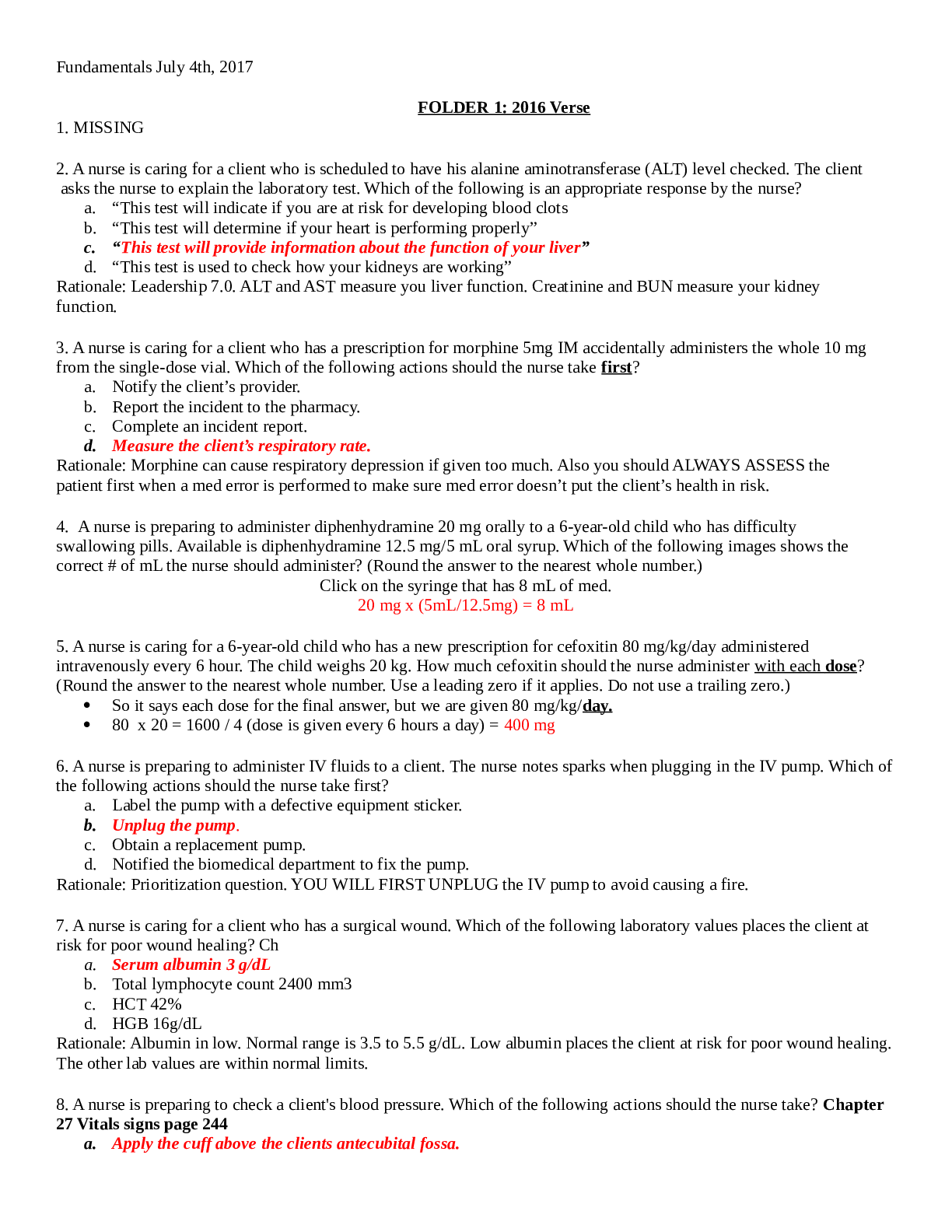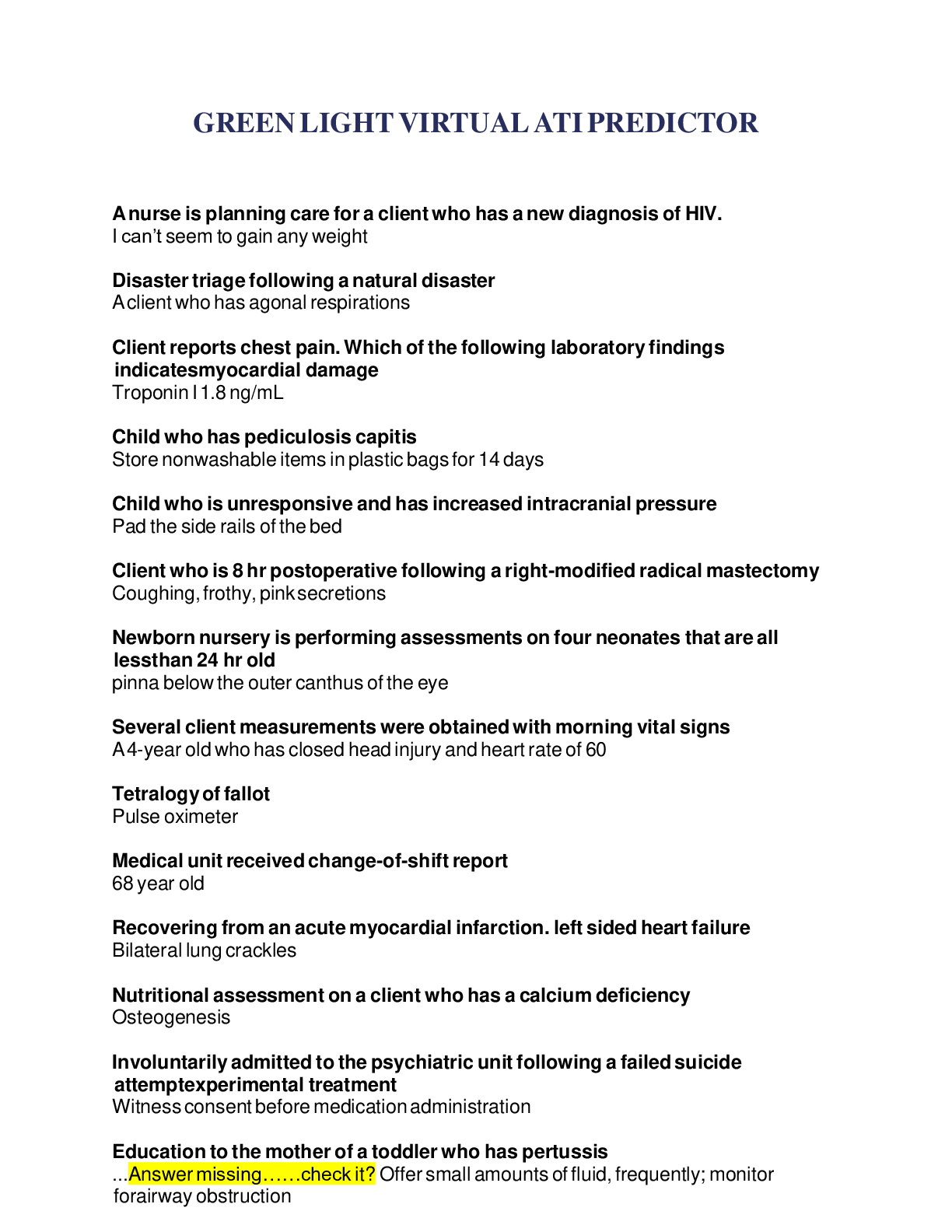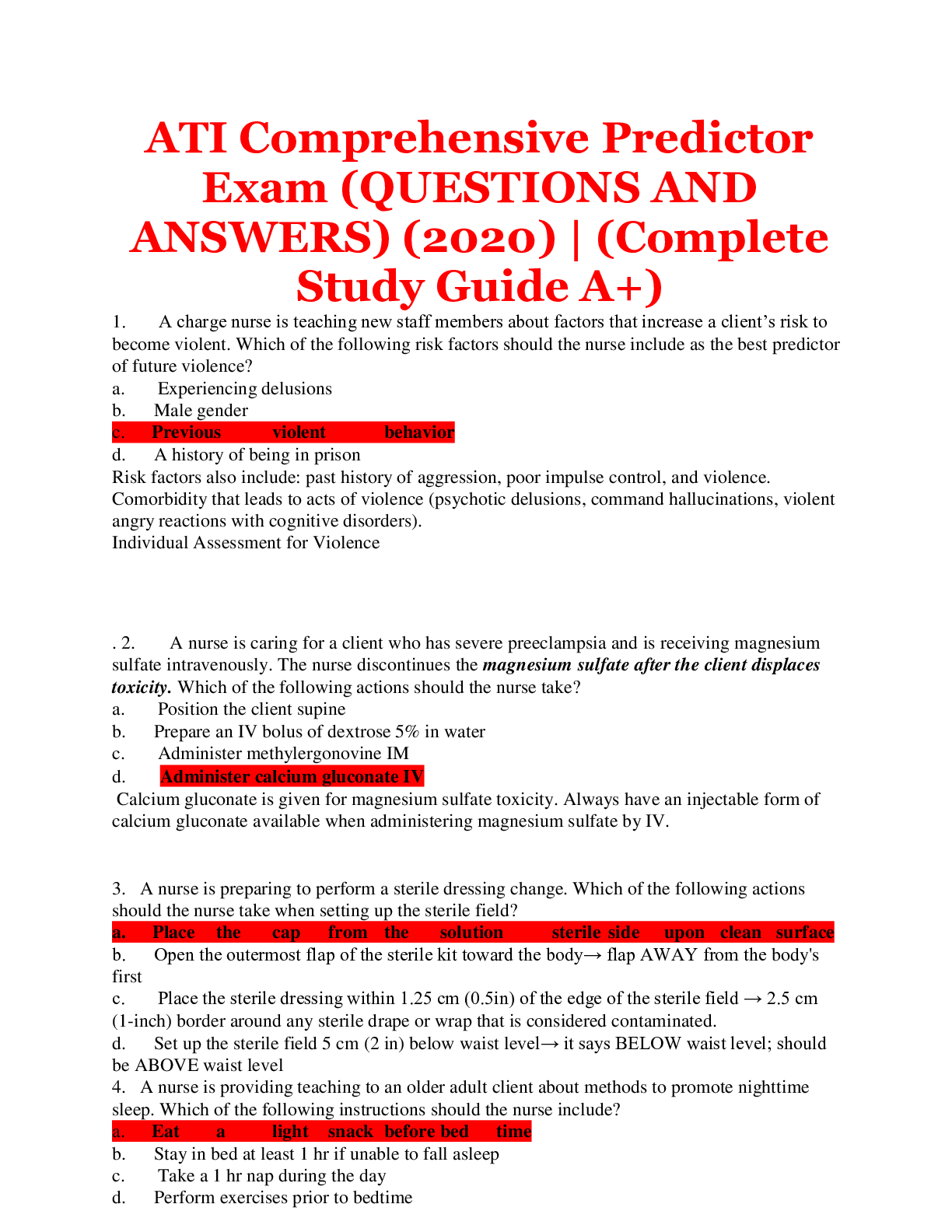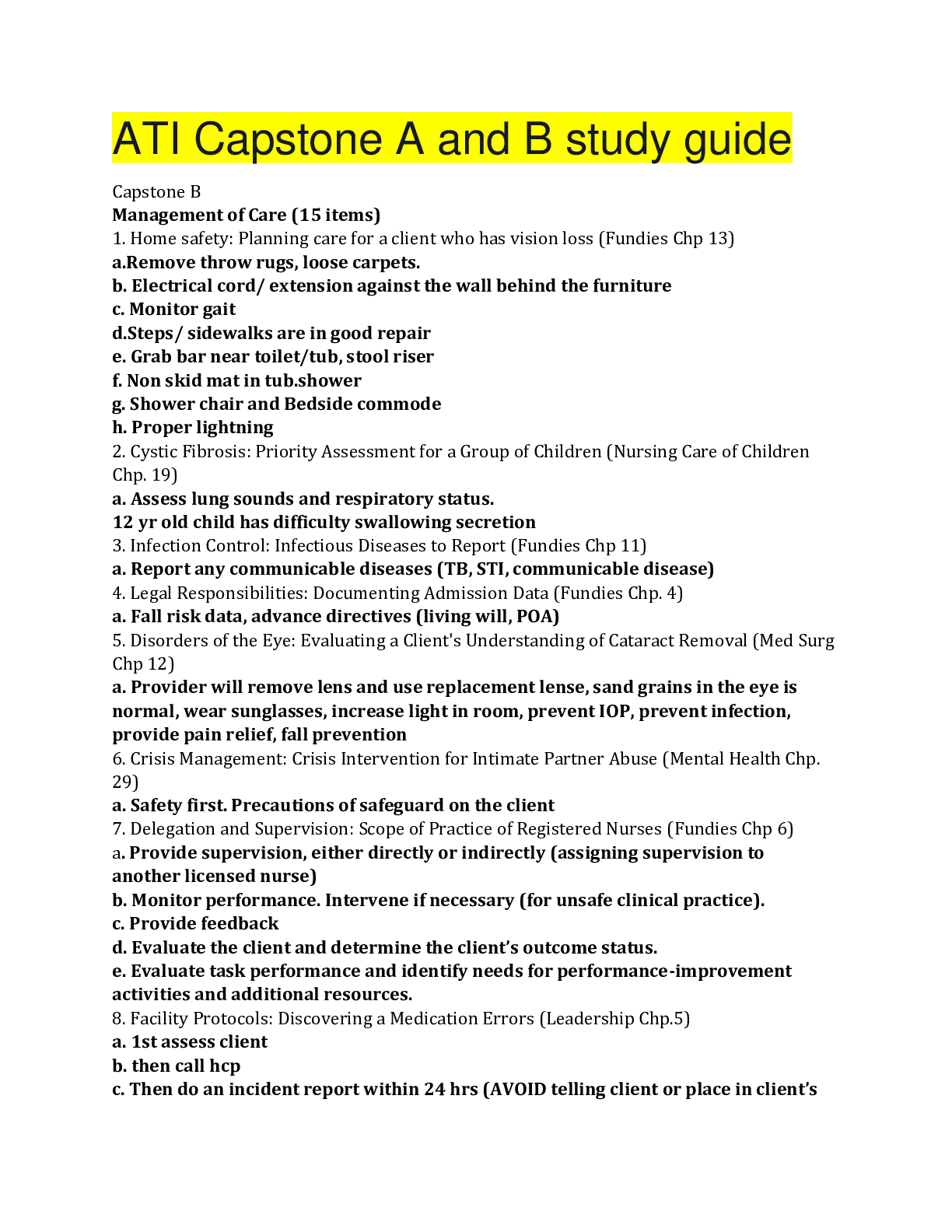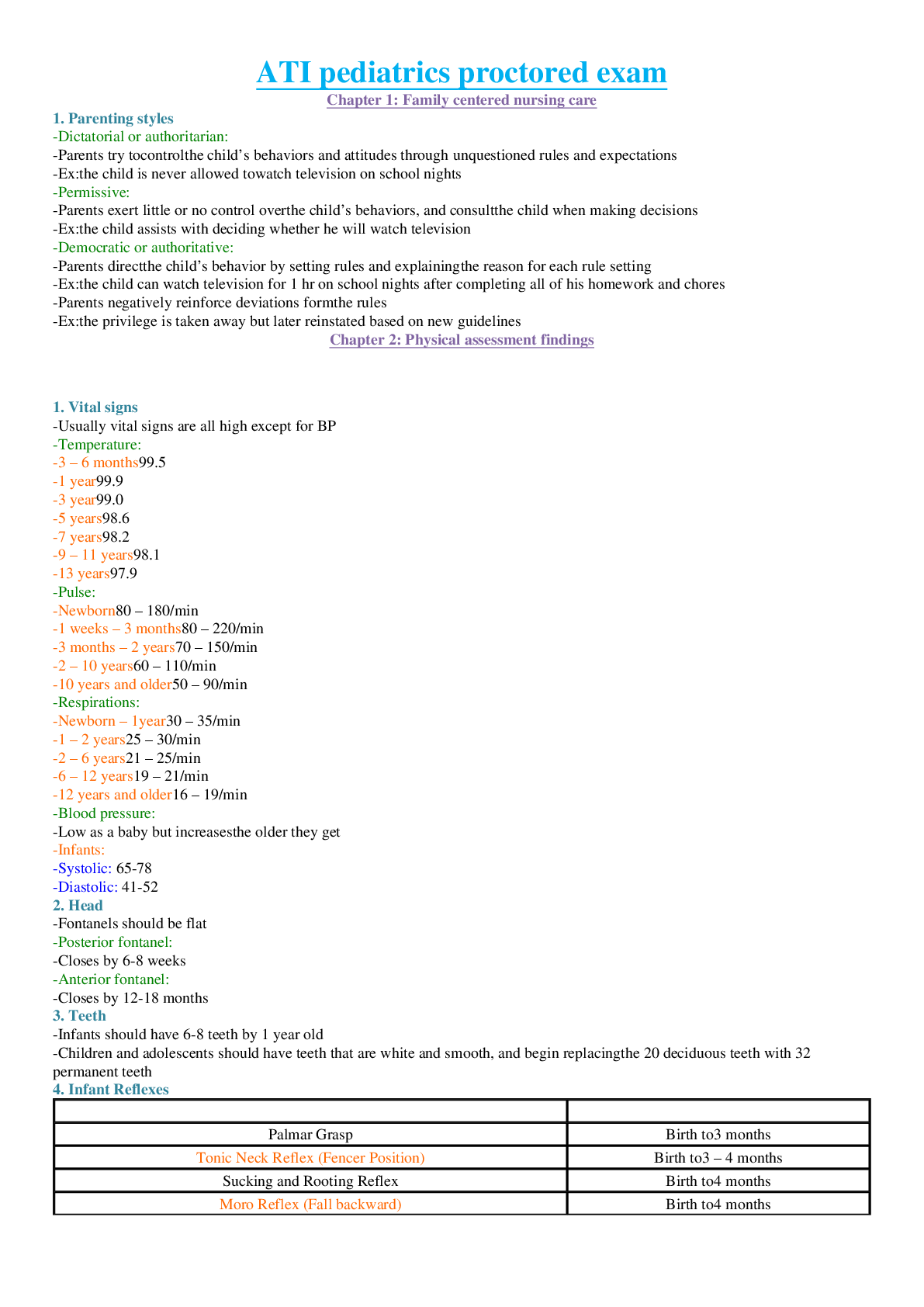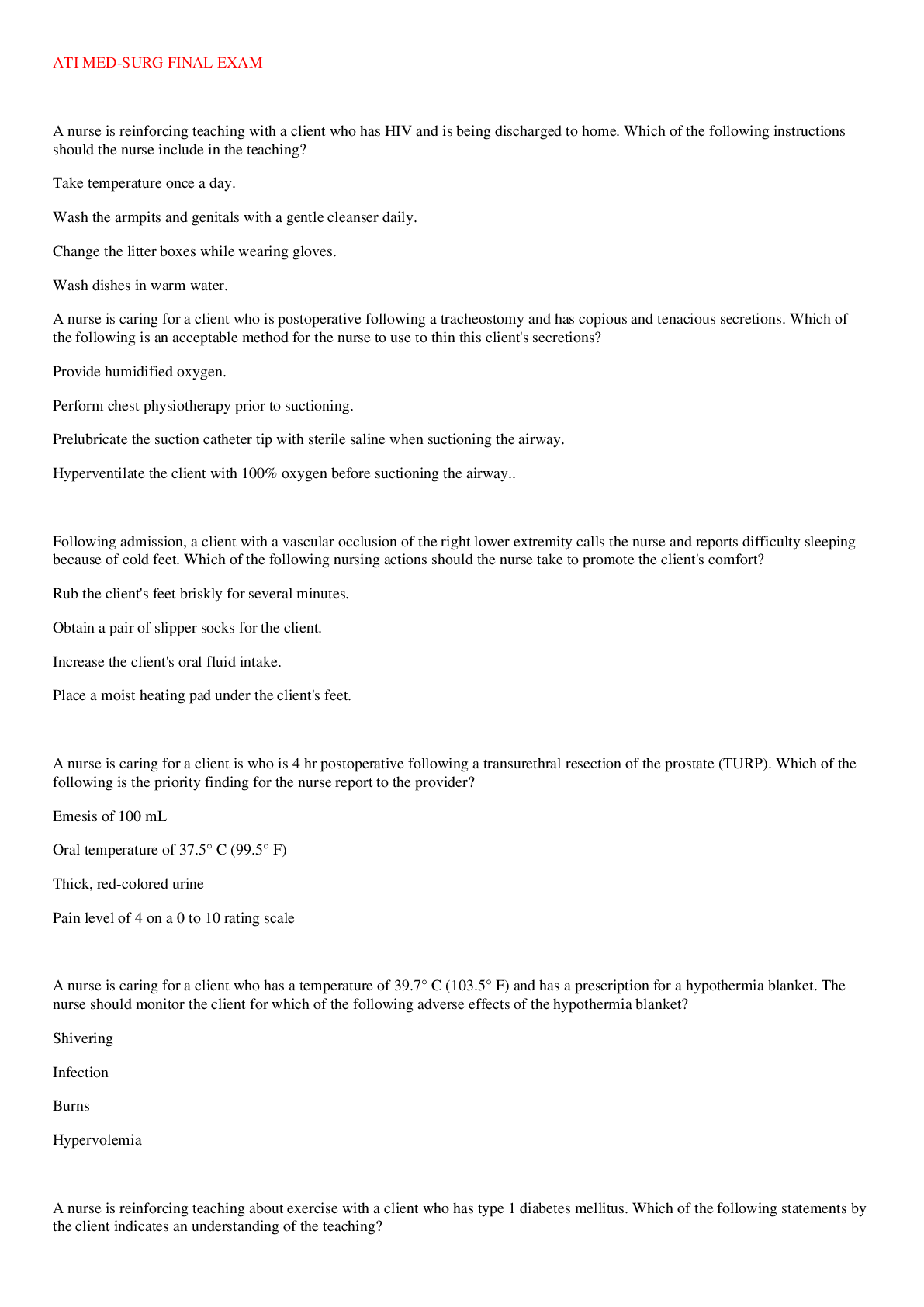*NURSING > QUESTIONS and ANSWERS > NR 603 Comparison and Contrast Assignment: Migraine and Post-Concussive Syndrome (All)
NR 603 Comparison and Contrast Assignment: Migraine and Post-Concussive Syndrome
Document Content and Description Below
Walker- Migraine Headache and Tension Headache Week 1 Part 1: Due Wednesday by 1159PM MT MN You will research the two areas of content assigned to you and compare and contrast them in discussion pos... t. NOTE: A comparison and contrast assignment is not about listing the info regarding each disease separately but rather looking at each disease side by side and discussing the similarities and differences given the categories below. Consider how each patient would actually present to the office. Consider how their history would affect their diagnosis, etc. Evaluation of mastery is focused on the student's ability to demonstrate specific understanding of how the diagnoses differ and relate to one another. Address the following topics below in your own words: Presentation Pathophysiology Assessment Diagnosis Treatment Dr. Ameri and class, Walker- Migraines and Tension headaches Presentation: Migraines in adults are of moderate to severe intensity, unilateral, and described as a throbbing or pulsating sensation. The patient may complain of nausea, vomiting, an aura, and sensitivity to light, noise, and/or smells. The patient may feel foggy after a migraine (Moriarty & Mallick- Searle, 2016). Tension-type headaches is the common headache and usually doesn’t require seeking medical attention. Tension-type headaches are of mild to moderate pain intensity, bilateral, described as dull pain or pressure, and do not throb. These patients may suffer from less than 15 headaches per month and they may last anywhere from 30 minutes to 7 days. Tension-type headaches are not aggravated by physical activity unlike migraines. Patients with tension-type headaches won’t have symptoms of nausea or vomiting. Tension-type headaches may cause a sensitivity to light or noise but not both (Rizzoli & Mullally, 2018). In all reality, migraines are associated with more severe pain, may be debilitating, and may require medical management to improve quality of life (Moriarty & Mallick-Searle, 2016). Pathophysiology: Migraines are a multi-factorial, recurrent, and hereditary headache disorder. Migraines may have prodromes or auras that exhibit several hours before the migraine occurs (Burstein, Noseda, & Borsook, 2015). Auras are correlated to four different aspects of the brain: hypothalamus, brainstem, cortex, or limbic system. It is believed that migraines begin in areas of the brain capable of initiating an aura, but the headache occurs from the consequential activation of meningeal nociceptors (Burstein et al., 2015). Tension-type headaches are associated with an activation of nociceptors too, but the pain receptors are located in the pericranial myofascial tissues. Muscular pain tends to be dull, achy, and poorly localized which is often times how tension-type headaches feel to patients. Studies have shown that patients with an increased sensitivity to stimuli (even harmless stimuli) in the pericranial myofascial tissues are likely to exhibit more frequent tension-type headaches (Hanier & Matheson, 2013). Migraines and tension-type headaches are similar in the fact that the activation of nociceptors cause pain but the location of these pain receptors differ in location and cause different intensities of pain. Assessment: The writer would perform a neurological examination for both cases; however, it is easy to distinguish between a migraine or tension headache based on the patient’s presentation. Obtaining a proper history including onset, location, duration, characteristics, aggravating, relieving, treatment, and severity. The provider should ask when the headaches first began, if any trauma has occurred, and family history of migraines. It is important to ask about mental health, sleep disorders, current medications the patient is taking, and social history (Weatherall, 2015). Observe how the patient walks including gait, posture, speed, symmetry, and coordination when getting on the exam table. Assess the patient’s speech, use of language, and facial symmetry. Assess the patient’s mental status. Perform an examination on cranial nerves I-XII. Assess the motor system of the upper and lower extremities with active range of motion with and without resistance for signs of weakness or differences of strengths. Assess for sensation of the face and all four extremities (Buttaro, Trybulski, Polar-Bailey, & Sandburg-Cook, 2017). Serious exam findings may include: new onset of headache after the age of 50, personality change, papilledema, decreased deep tendon reflexes, painful temporal arteries, asymmetry of pupillary responses (Buttaro, Trybulski, Polgar-Bailey, & Sandburg-Cook, 2017). Diagnosis: The diagnosis of migraines and tension-type headaches are made upon presentation without lab or imaging. The International Classification of Headache Disorders (ICHD) is a tool utilized to diagnose between different types of headaches. Patients with migraines have to have at least 5 attacks that last anywhere from 4 to 72 hours and had a least two of the four characteristics: unilateral location, pulsating quality, moderate to severe pain, and/or aggravated by routine physical activity. The patient will also complain of nausea, vomiting, or sensitivity to light and/or noise (Weatherall, 2015). Tension-type headaches are diagnosed based upon the ICHD and the patient may have a headache occurring on 1 to less than 15 days per month with mild to moderate severity, non-pulsating, and the headache is not aggravated by physical activity (Weatherall, 2015). The difference between the two headaches is based upon subjective data retrieved from the patient and the use of the ICHD will assist the provider to diagnose the condition. Imaging may be warranted if papilledema is seen on fundoscopy, new onset of seizures, changes in memory or coordination, or if the patient has a history of cancer (Weatherall, 2015). Treatment: The first line treatment for migraines are non-steroidal anti-inflammatory drugs (NSAIDS) and second line treatment is a Triptan. According to Mayans & Walling (2018), ibuprofen is often chosen as first line treatment because of its availability and tolerability. NSAIDS are used if the migraine is of mild to moderate severity. Triptans are prescribed for moderate to severe migraines and Imitrex is most commonly used for it’s efficacy and price. Ibuprofen 400mg q4-6hr PRN for mild to moderate pain (Ibuprofen, 2019) Rx: Sumatriptan 25mg tablet Sig: Take 1 tablet at onset of headache and repeat 1 tablet in 2 hours if needed but not to exceed 200mg/24 hours Quantity: 9 (nine) RF: 0 (zero) (Sumatriptan, 2019) According to Burch (2019), the treatment for tension-type headaches include over-the-counter medications of Tylenol, ibuprofen, or aspirin and prescription NSAIDS of ketoprofen and diclofenac. As a provider, the student would suggest an OTC ibuprofen for the treatment of the tension-type headache prior to writing a prescription. Ibuprofen 400mg q4-6hr PRN for mild to moderate pain (Ibuprofen, 2019) The first line treatment option for both conditions is the same, but it is important to note that Triptans which are second line treatment for migraines is actually not beneficial for the treatment of true tension-type migraines because Triptans do not have an effect on muscular pain (Burch, 2019). Thank you, Emily Burch, R. (2019). Migraine and tension-type headache: Diagnosis and treatment. Medical Clinics of North America, 103(2), 215–233. doi:10.1016/j.mcna.2018.10.003 Burstein, R., Noseda, R., & Borstook, D. (2015). Migraine: Multiple processes, complex pathophysiology. The Journal of Neuroscience, 35(17), 6619-6629. doi: 10.1523/JNEUROSCI.0373-15.2015 Buttaro, T., Trybulski, J., Polgar-Bailey, P., & Sandburg-Cook, J. (2017). Primary care: A collaborative practice (5th ed.). Retrieved from https://online.vitalsource.com Hainer, B. L. & Matheson, E. M. (2013). Approach to acute headache in adults. American Family Physician, 87(10), 682-687. Retrieved from https://www.aafp.org/afp/2013/0515/p682.html Ibuprofen. (2019). In Epocrates online. Retrieved from https://online.epocrates.com/drugs/233/ibuprofen International Headache Society. (2018). The International Classification of Headache Disorders, 3rd edition. Cephalgia, 38(1), 1-211. doi: 10.1177/0333102417738202 Kroon Van Diest, A. M., Ernst, M. M., Slater, S., & Powers, S.W. (2017). Similarities and differences between migraine in children and adults: Presentation, disability, and response to treatment. Current Pain and Headache Reports, 21(12), 48. doi: 10.1007/s11916-017-0648-2 Mayans, L. & Walling, A. (2018). Acute migraine headache: Treatment strategies. American Family Physician, 97(4), 243-251. Retrieved from https://www.aafp.org/afp/2018/0215/p243.html Moriarty, M. & Mallick-Searle, T. (2016). Diagnosis and treatment for chronic migraine. The Nurse Practitioner, 41(6), 18-32. doi: 10.1097/01.NPR.0000483078.5590.3b Rizzoli, P. & Mullally, W. J. (2018). Headache. The American Journal of Medicine, 131(1), 17- 24. doi: 10.1016/j.amjmed.2017.09.005 Sumatriptan. (2019). In Epocrates online. Retrieved from https://online.epocrates.com/u/1011681/sumatriptan/Adult+Dosing Weatherall, M. (2015). The diagnosis and treatment of chronic migraine. Therapeutic Advances in Chronic Disease, 6(3), 115-123. doi: 10.1177/2040622315579627 wATCH THIS Shannon, It is interesting that delirium is not dementia but patients with history of dementia are at double the risk for experiencing delirium (Mulkey, Roberson, Everhart, & Hardin, 2018). Delirium is acute, but dementia is chronic. A patient with a history of dementia that lives in an assisted living facility may experience delirium if he or she contracts a urinary tract infection. This patient may require inpatient hospital stay to receive antibiotics, but not all patients with delirium may need to be hospitalized. It is important to understand different screening tools that may used for different settings. Shannon, you wrote about the Confusion Assessment Method (CAM) for inpatient stays, but the Family CAM is beneficial for caregivers to use in an outpatient setting (Mulkey et al., 2018). Last week in clinical, a daughter brought her dad in for evaluation of his delirium. The daughter stated that the patient had fallen at home and was hospitalized for 3 days and had been confused since he was discharged. The Family CAM tool would have been helpful in this situation and it was a relief for the daughter when the student spoke to her about the difference in acute delirium versus dementia. The writer researched further on when patients should be screened for dementia in the primary care setting. According to the U. S. Preventative Service Task Force (USPSTF) (2015), a patient age 65 and older should not be screened without signs or symptoms of cognitive impairment. It denotes that increasing age is the strongest risk factor for impaired mental capacity and that 5% of the population aged 71 to 79 years of age and 37% of the population over 90 years old suffer from cognitive impairment. Other risk factors for dementia include diabetes, smoking, hyperlipidemia, hypertension, low socioeconomic status, depression, head trauma, etc. (USPSTF, 2015). Many of these risk factors are modifiable and it is important to educate our patients on the benefits of a healthy and active lifestyle. Besides pharmacological therapy, non- pharmacological interventions to improve cognitive impairment include cognitive training and delaying institutionalization (USPSTF, 2015). It is important for these patients to have a caregiver that promotes memory recall and reorientation. Thank you, Emily Mulkey, M. A., Roberson, D. W., Everhart, D. E., & Hardin, S. R. (2018). Choosing the right delirium assessment tool. Journal of Neuroscience, 50(6), 343-348. doi: 10.1097/JNN.0000000000000403 U. S. Preventative Services Task Force. (2015). Screening for cognitive impairment in older adults: Recommendation statement. American Family Physician, 91(6). Retrieved from https://www.aafp.org/afp/2015/0315/od2.html [Show More]
Last updated: 1 year ago
Preview 1 out of 6 pages
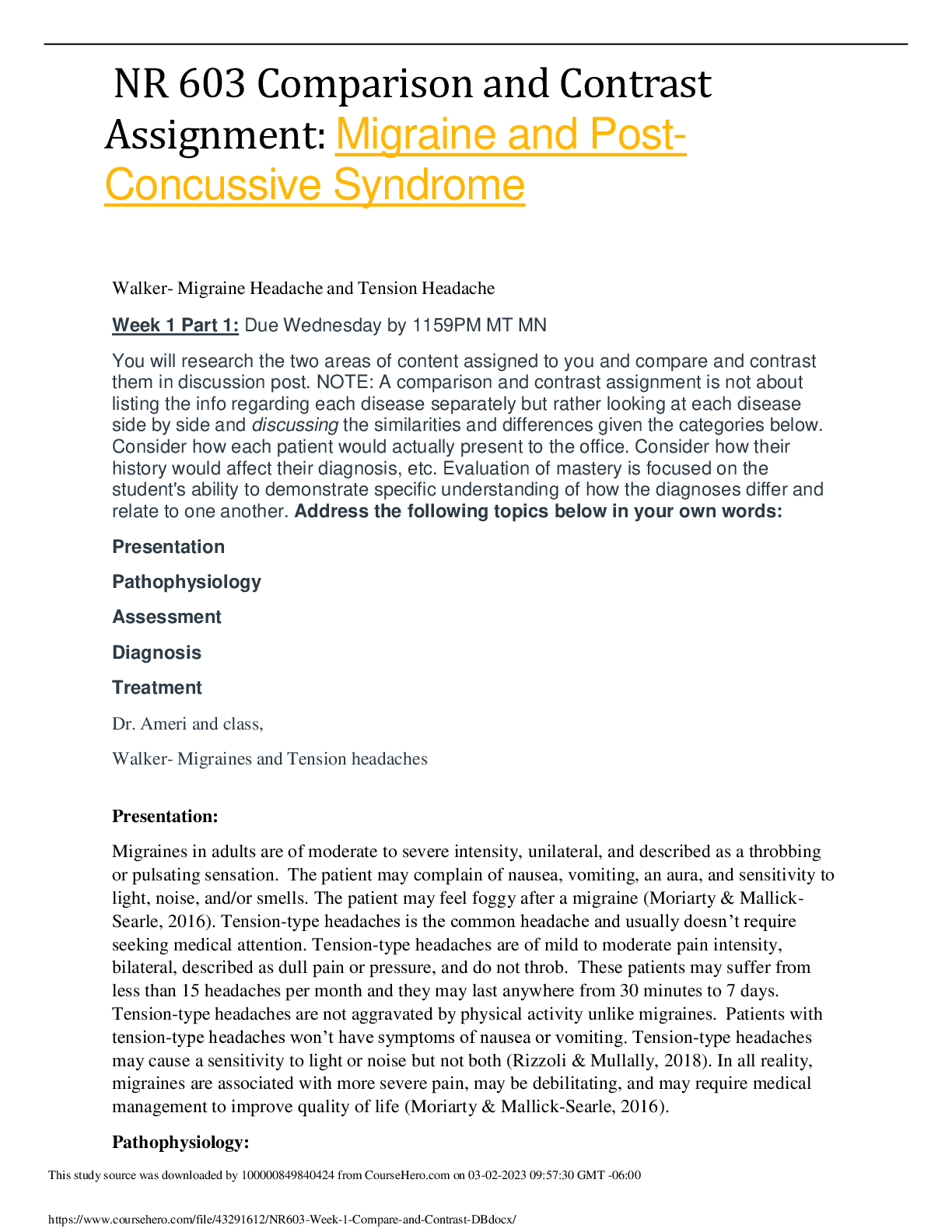
Reviews( 0 )
Document information
Connected school, study & course
About the document
Uploaded On
Mar 02, 2023
Number of pages
6
Written in
Additional information
This document has been written for:
Uploaded
Mar 02, 2023
Downloads
0
Views
62


